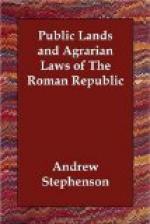If we examine the objections which Ihne raises we shall not find them so formidable as first appears. Mommsen does not say that the number of citizens was increased. What he does say is that the number of burgesses capable of bearing arms was increased (vol. III, p. 128). In 570-184, the Servian Military Constitution was so modified as to admit to service in the burgess army, persons possessed of but 4,000 asses ($85). In case of need all those who were bound to serve in the fleet, i.e. those rated between 4,000 and 1,500 asses and all freedmen, together with the free-born rated between 1,500 asses ($30) and 375 asses ($7.50), were enrolled in the burgess infantry.[17] It is easy enough to see that the gift on the part of the government of 30 jugera (24 acres) of land to each poor citizen, would raise him from the ranks of the proletariate and make him liable to military service.
This is sufficient to establish Mommsen’s thesis;[18] and it is not necessary to consider the second point, viz., that non-citizens were not to share in the benefit of the land law nor thereby to be raised to the rank of citizens, although to us it would be no more difficult to believe this than that 76,000 allies had been admitted to the Roman franchise “by several plebiscites” no trace or rumor of which had been preserved.
It can hardly be supposed that the Italian farmers were multiplied at the same ratio as were the Romans; but the result must have been most beneficial even to them.
In the accomplishing of this result, respectable interests and existing rights were no doubt violated. The commission itself was composed of violent partisans who, being judges unto themselves, did not scruple to carry out their plans even at the cost of recklessness and tumult. Loud complaints were made, but usually to no avail. If the domain question was to be settled at all, the matter could not be carried through without some such rigor of action. Intelligent Romans wished to see the plan thoroughly tested. But this acquiescence had a limit. The Italian domain was not all in the hands of Roman citizens. Allied communities held the usufruct of large tracts of it by means of decrees of the people or the senate, and other portions had been taken possession of by Latin burgesses. These in turn were attacked by the commissioners; but to give fresh offense to these Latini, who were already overburdened with military service, without share in the spoils, was a matter of doubtful policy.




